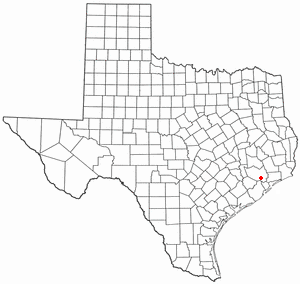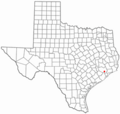Allen Ranch facts for kids
The Allen Ranch, also known as the Sam Allen Ranch, was one of the very first and longest-lasting ranches in the history of Texas. It started just a few years after the Texas Revolution. This huge ranch was located in what is now southeast Houston and Pasadena. It stretched from Clear Lake all the way to Harrisburg (which is now part of east Houston). The land where the cattle roamed covered a large part of southeast Harris County and Galveston County. This included many of the towns you see today around Galveston Bay.
The Allen Ranch made a lot of money, and its success helped Houston, Harrisburg, and Pasadena grow in their early days. It also played a big part in the economy of Galveston during the 1800s.
How the Ranch Began
Samuel W. Allen came to the new Republic of Texas in 1842. He was a young man looking for new chances. He arrived in the small town of Harrisburg (now part of east Houston). Soon after, he married into the Thomas family. This family had come to Texas with Stephen F. Austin's first group of settlers.
Using land from the Thomas family's grant, which was along the Buffalo Bayou between Harrisburg and Galveston Bay, Sam Allen started his cattle ranch in 1844. This area is now Pasadena. His cattle land stretched even further along the bay's shoreline.
Like many ranchers in Texas, Allen started his herd by gathering Longhorn cattle. These cattle were descendants of animals brought by the Spanish to the Americas. They roamed freely across Texas. Allen's herd grew very quickly. By the 1860s, he had special agreements to ship his cattle to New Orleans and Cuba. He used the Morgan Lines, which was Texas' first steamship company. This company later helped make Houston an important port and shipping center for railroads.
Growing and Prospering
Allen's wealth grew very fast after the American Civil War. He partnered with others and bought more land. This made his main ranch much bigger. He also gained ranch lands in other parts of Texas. He built processing plants near his ranch along the Buffalo Bayou and in Galveston. These plants processed cattle hides (skins) and tallow (animal fat).
Railroads were built through the Allen Ranch. The Galveston, Houston and Henderson Railroad came through in the 1850s. Later, the Gulf, Colorado and Santa Fe Railway and the La Porte, Houston and Northern Railroad also crossed the ranch. The ranch had its own docks along the Buffalo Bayou. These docks became major shipping points. They helped the area grow into what is now the Houston Ship Channel. The ranch even had its own private train station called "El Buey," which means "The Ox" in Spanish.
Samuel W. Allen's son, Samuel E. Allen, took over running the ranch. Even though some of Sam W. Allen's other businesses didn't do well, the Allen Ranch kept growing and making money. It became the largest ranch in the region and one of the biggest in Texas. By 1900, the Allen Ranch covered over 17,000 acres (about 69 square kilometers). Most of this land was in Harris County, with pastures also in Galveston County and other nearby counties. The main parts of the ranch covered much of modern Pasadena, southeast Houston, Clear Lake City, and La Porte.
The Allen family also invested a lot of money in developing businesses in Galveston and Harrisburg, and later Houston. For example, they started the Oriental Textile Mills. This factory was once the world's largest maker of press cloth for the cotton industry. The Allens were also well-known and wealthy people in society throughout the region.
The Ranch Today
After Sam E. Allen passed away in 1913, much of the family's ranch land was sold. New homes and businesses were built on it as Pasadena and Houston grew. Sam E. Allen's son, Sam M. Allen, continued to operate the remaining part of the main ranch in Harris County. He also managed the ranch lands in Brazoria County. After Sam M. Allen died in 1947, the rest of the ranch was sold off.
Today, many areas in Houston, Pasadena, and other cities have names that remind people of the Allen family and their ranch properties.
Images for kids



